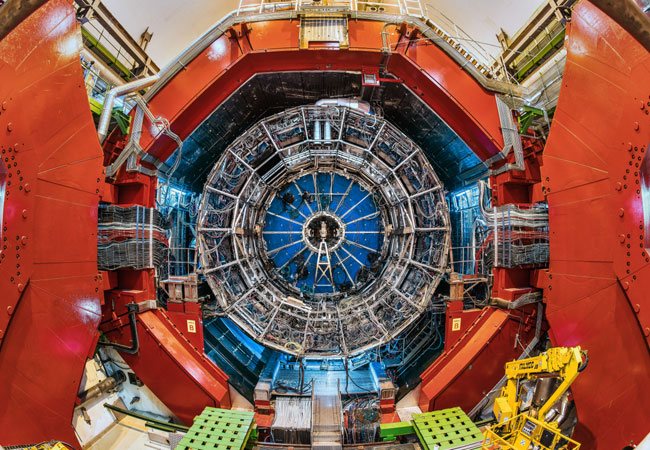
Extremely dense neutron stars may contain unstable hyperons in their interior, which, like the stable hadrons of the atomic nucleus, protons and neutrons, are held together by the strong interaction. Scientists from the ALICE collaboration at the accelerator centre CERN have now developed a method to precisely measure the strong interaction between unstable hadrons in experiments for the first time. Research teams from Goethe University headed by Professor Harald Appelshäuser and TU Munich headed by Professor Laura Fabbietti were involved in the development.
In an article published today in Nature, the ALICE collaboration describes a novel method that will allow precision measurements of the strong interaction between hadrons at the Large Hadron Collider (LHC) accelerator at CERN in Geneva.
Hadrons – which include protons and neutrons – are particles composed of two or three quarks, which are held together by the strong interaction. However, the interaction is not limited to the interior of the hadron, but extends beyond it. It leads to something known as residual interaction, due to which hadrons also exert forces on each other. The best-known example is the force between protons and neutrons, which is responsible for the cohesion of atomic nuclei. One of the great challenges of modern nuclear physics is to achieve an accurate calculation of the strong force between hadrons, which is based on the underlying strong interaction of quarks.
Within the framework of something known as „lattice QCD“ calculations, the effective strong force between hadrons can be calculated on the basis of the fundamental theory of the strong interaction between quarks. However, these calculations are only very accurate for hadrons containing heavy quarks. This applies, for example, to hyperons, i.e. hadrons that contain one or more strange quarks. Although the strong interaction caused by collisions of hadrons can be studied in scattering experiments, it is difficult to perform these experiments with unstable hadrons such as hyperons. Accordingly, an experimental comparison with the precise theoretical predictions from the lattice QCD for hyperons is difficult.
In today’s publication of the ALICE collaboration a method is presented which allows the study of the dynamics of the strong interaction for arbitrary pairs of hadrons. This concerns especially those hadrons which are short-lived, i.e. which decay after fractions of seconds and therefore cannot be investigated in scattering experiments. Instead, the hadrons are generated in proton-proton collisions at the LHC. The interaction between them can be measured on the basis of their relative momentum distribution.
Professor Laura Fabbietti from the TU Munich, who has contributed significantly to the results presented here, emphasises that this breakthrough is due to both the LHC and the ALICE detector. The LHC is able to generate a very large number of hadrons with strange quarks and thus provides an insight into the nature of the strong interaction. The ALICE detector and its high-resolution Time Projection Chamber (TPC), in turn, would provide the necessary precision to identify the particles accurately and measure their momentum accurately.
Harald Appelshäuser, professor at Goethe University, has been leading the ALICE TPC project for ten years and is co-author of the publication. He works closely with Laura Fabbietti’s Munich group and emphasises that the method presented would usher in „a new era of precision studies of the strong interaction between exotic hadrons at the LHC.“
The method presented is called femtoscopy because the processes examined take place in a spatial area of about 1 femtometre (10-15metres). This corresponds approximately to the size of a hadron and the range of the strong interaction. Using this method, the ALICE collaboration has already been able to study interactions between hyperons containing one or two strange quarks. In the publication, a measurement of the interaction between a proton and the omega (Ω) hyperon has now been investigated for the first time and with high precision. The omega is the rarest of all hyperons and consists of three strange quarks.
Professor Appelshäuser emphasises that the significance of the results goes beyond the verification of theoretical calculations: „Femtoscopic investigations can significantly expand our understanding of very dense stellar objects such as neutron stars, which can contain hyperons in their interior and whose interaction is still largely unknown.“
Publication: Shreyasi Acharya et al. (ALICE Collaboration): Unveiling the strong interaction among hadrons at the LHC. Nature, 9 December 2020, https://doi.org/10.1038/s41586-020-3001-6
Explanatory video by TU Munich on this subject:
Rätselhafte Neutronensterne – Präzise Messung der starken Wechselwirkung – YouTube







